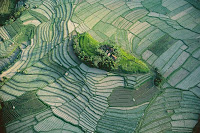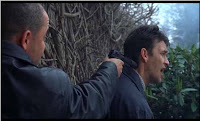In the world of media, the camera films what the eye see's, capturing footage that can be presented in many ways for example, angles, shot types and movement.
ANGLES
The Bird's-Eye view

This shows a scene from directly overhead, a very strange angle. This shot puts the audience in a godlike position, looking down on the action. People can be made to look insignificant,and important.
High Angle

The camera is elevated above the action to give a general overview. High angles make the object photographed seem smaller, and less significant. The object or character often gets swallowed up by their setting becoming a wider part of the picture.
Eye Level
A neutral shot; the camera is positioned as though it is a human actually observing a scene, so the camera could be at the same level the characters are along with the focus. The camera would usually be placed around five to six feet from the ground.
Low Angle

These increase height (which could be useful for short actors/actresses) giving a sense of speeded motion. Low angles help give a sense of confusion to a viewer, of powerlessness within the actor of a scene with a lot of action . Usually the background of a low angle shot will be just the sky or ceiling, the lack of detail in the setting adds to the disorientation of the viewer. The added height of the object may make it inspire fear and insecurity within the audience.
Oblique/Canted Angle

Sometimes the camera is tilted (not being placed horizontal to the floor), to suggest imbalance, transitio n and instability, a hand held camera is often used for this.
Shot types
Extreme long shot
Generally these shots are used as a scene-setting, establishing shot. It normally shows an exterior, e.g. outside of a building, or a landscape, and is often used to show scenes of thrilling action. There is usually very little detail visible in the shot, this show is just for an general impression so the audience understand where the film is set.
Long Shot

This shot genrally shows the image as approximately "life" size corresponding to the real distance between the audience and the screen in a cinema. This category includes the full shot showing the entire human body, with the head near the top of the frame and the feet near the bottom. While the focus is on characters, plenty of background detail still emerges.
Medium Shot

Most oftern this shot contains a figure from the knees/waist up and is normally used for dialogue scenes, or to show some detail of action. Background detail is minimal, most likely because location has already been established earlier in the scene - allowing the audience to now focus on dialogue and character interation.
Close-Up

This shot shows very little background, and concentrates on either a face, or a specific detail of mise en scène. Everything else is just a blur in the background. This shot magnifies the object taking up most space of the camera/screen and shows the importance of things. The close-up takes us into the mind of a character. In reality, we only let people that we really trust get THAT close to our face - so a close up of a face is a very intimate shot. Film-makers use this to make us feel comfortable or extremely uncomfortable about a character.
Extreme Close-Up

This shot generally magnifies beyond what the human eye would experience in reality. An extreme close-up of a face, for instance, would show only the mouth or eyes, with no background detail. This shot, can be used for dramatic effect. The tight focus required means that extra care must be taken when setting up and lighting the shot - the slightest camera shake or error in focal length is very noticeable.
Over the shoulder shot

An over the shoulder shot is a shot of someone or something taken over the shoulder of another person. The back of the shoulder and head of this person is usually in the frame and the camera is pointing over the shoulder at the other character. This type of shot is very common when two characters are having a discussion.
Movement
Pans
A movement which scans a scene horizontally. The camera is placed on a tripod, which operates as a stationary axis point as the camera is turned, often to follow a moving object which is kept in the middle of the frame.
Tilts
A movement which scans a scene vertically, otherwise similar to a pan.When tilting thecamera base stays static, whilst the camera moves up or down vertically.
Tracking
The camera is placed on a moving vehicle and moves alongside the action, generally following a moving figure or object. The camera base moves sideways following the action, the camera is move on a dolly or set of rails. Dolly shots will involve a track being laid on set for the camera to follow, the camera might be mounted on a car, a plane, or even a shopping trolley
Handheld
The camera is placed on a moving vehicle and moves alongside the action, generally following a moving figure or object. The camera base moves sideways following the action, the camera is move on a dolly or set of rails. Dolly shots will involve a track being laid on set for the camera to follow, the camera might be mounted on a car, a plane, or even a shopping trolley
Handheld
Handheld camera work can also be used to follow action or to show events from a charecters point of view. Hand held cameras denote a certain kind of gritty realism, and they can make the audience feel as though they are part of a scene, rather than viewing it from a detached, frozen position.
No comments:
Post a Comment